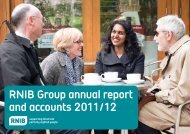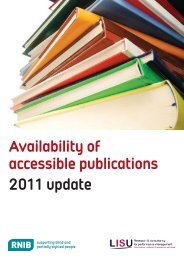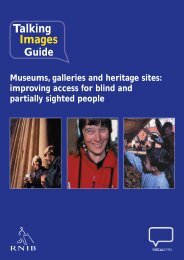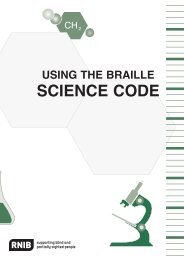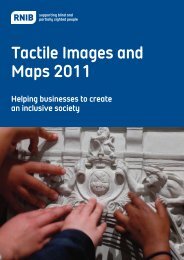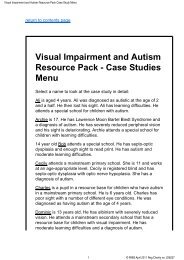Download Complete Report (PDF 1.19mb) - RNIB
Download Complete Report (PDF 1.19mb) - RNIB
Download Complete Report (PDF 1.19mb) - RNIB
You also want an ePaper? Increase the reach of your titles
YUMPU automatically turns print PDFs into web optimized ePapers that Google loves.
1. Radio and bind and partially sighted people – background<br />
experiences of several communications services, the depth of focus the Ofcom study<br />
was able to give to radio use was more limited than that afforded by the current<br />
project.<br />
1.8. Switchover to digital radio<br />
If a switchover to digital radio takes place at any stage, like the digital television<br />
switchover process, digital radio would be the only way to receive the major public<br />
service and commercial radio channels. This is a factor accentuating the importance of<br />
supporting access for blind and partially sighted people to digital radio equipment.<br />
1.9. Access to digital radio – an <strong>RNIB</strong> focus<br />
Listening to the radio is important to blind and partially sighted people and so<br />
accessibility and usability of consumer digital radio equipment is of high importance<br />
(eg Douglas et al., 2006). A concern of <strong>RNIB</strong> is that a valued existing pastime<br />
(listening to the radio) and the benefits of new and emerging features and functions<br />
should be as accessible to blind and partially sighted consumers, as they are to sighted<br />
consumers.<br />
In this context, the current research was commissioned by <strong>RNIB</strong> to identify equipment<br />
design considerations to support accessibility to digital radio by blind and partially<br />
sighted consumers.<br />
The aims and objectives of the current research, and the research questions addressed<br />
in it are described in Chapter 2.<br />
The research methods used (in home in depth interviews and telephone interviews with<br />
blind, partially sighted and sighted consumers, and semi-structured interviews with<br />
representatives from the consumer digital radio equipment supply chain) and the<br />
research participants sampled are described in detail in Chapter 3.<br />
Chapters 4 to 10 present the results of both the consumer research activities, and the<br />
industry interviews, including the full consumer digital radio equipment design<br />
consideration checklist (in Chapter 9).<br />
The report conclusions are presented in Chapter 11, and finally, the Appendices include<br />
the questionnaire used for the project’s Short Preference Survey, and table format<br />
presentations of all charted data.<br />
18



